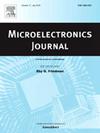用于自供电无线传感器的带 MPPT 的高效电源管理电路
IF 1.9
3区 工程技术
Q3 ENGINEERING, ELECTRICAL & ELECTRONIC
引用次数: 0
摘要
在本文中,我们提出了一种专为低功率电磁振动能量收集器设计的电源管理电路(PMC),能够在低至 1.1V 的交流电压下工作。该电源管理电路由一个有源四倍电压整流器模块、一个最大功率点跟踪(MPPT)模块、一个直流-直流转换器模块、一个能量充放电管理模块和一个能量存储单元组成。使用电磁振动能量收集器(EVEH)进行了实验验证。有源四倍电压整流器利用单个比较器调节相同的 MOSFET,从而减少了元件数量。为了提高 MPPT 过程的稳定性和准确性,引入了一种利用滞后比较器的新型 MPPT 技术。结果表明,MPPT 跟踪误差最小为 7.32%,PMC 的整体转换效率 (CE) 达到 89.70% 的高效率,而收割机的输出功率为 1.67 mw。本文章由计算机程序翻译,如有差异,请以英文原文为准。
An efficient power management circuit with MPPT for self-powered wireless sensors
In this paper, we proposed a power management circuit (PMC) specifically designed for low-power electromagnetic vibrational energy harvesters, capable of operating with AC voltage as low as 1.1V. The PMC consists of an active quadruple voltage rectifier module, a maximum power point tracking (MPPT) module, a DC-DC converter module, an energy charging and discharging management module, and an energy storage unit. Experimental validation was performed using an electromagnetic vibration energy harvester (EVEH). The active quadruple voltage rectifier utilizes a single comparator to regulate identical MOSFETs, thereby reducing component counts. A novel MPPT technique utilizing hysteresis comparators is introduced to enhance the stability and accuracy of MPPT process. Results indicate a minimal MPPT tracking rate error 7.32 %, and the overall conversion efficiency (CE) of the PMC reaches a high efficiency of 89.70 % while the output power of the harvester is 1.67 mw.
求助全文
通过发布文献求助,成功后即可免费获取论文全文。
去求助
来源期刊

Microelectronics Journal
工程技术-工程:电子与电气
CiteScore
4.00
自引率
27.30%
发文量
222
审稿时长
43 days
期刊介绍:
Published since 1969, the Microelectronics Journal is an international forum for the dissemination of research and applications of microelectronic systems, circuits, and emerging technologies. Papers published in the Microelectronics Journal have undergone peer review to ensure originality, relevance, and timeliness. The journal thus provides a worldwide, regular, and comprehensive update on microelectronic circuits and systems.
The Microelectronics Journal invites papers describing significant research and applications in all of the areas listed below. Comprehensive review/survey papers covering recent developments will also be considered. The Microelectronics Journal covers circuits and systems. This topic includes but is not limited to: Analog, digital, mixed, and RF circuits and related design methodologies; Logic, architectural, and system level synthesis; Testing, design for testability, built-in self-test; Area, power, and thermal analysis and design; Mixed-domain simulation and design; Embedded systems; Non-von Neumann computing and related technologies and circuits; Design and test of high complexity systems integration; SoC, NoC, SIP, and NIP design and test; 3-D integration design and analysis; Emerging device technologies and circuits, such as FinFETs, SETs, spintronics, SFQ, MTJ, etc.
Application aspects such as signal and image processing including circuits for cryptography, sensors, and actuators including sensor networks, reliability and quality issues, and economic models are also welcome.
 求助内容:
求助内容: 应助结果提醒方式:
应助结果提醒方式:


